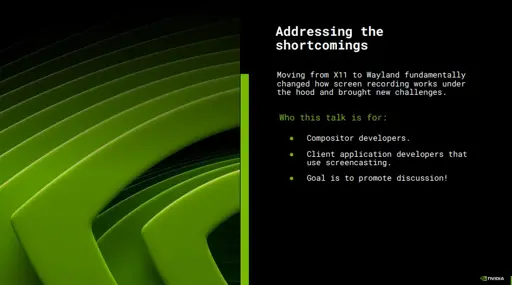In addition to showing the need for unifying DRM driver-side APIs within the Linux kernel, NVIDIA’s Linux graphics driver team at XDC2025 also showcased the shortcomings of screencasting under Wayland.
Doğukan Korkmaztürk of NVIDIA presented on the issues that persist with screencasting under Wayland from both the compositor and client perspectives. From the state of explicit synchronization to performance differences compared to X11, there are some pain points that ultimately still need to be addressed for a better screen casting/capturing experience on Wayland.



Lazy headline from Phoronix makes it sound like Nvidia is just complaining about Wayland. It’s a technical presentation aimed at Wayland developers to discuss shortcomings that make it difficult to implement screen casting. A talk like this from a hardware vendor who is an active contributor to Wayland, and develops/maintains drivers is very helpful, and the first step to addressing/fixing the issues.
I hate Nvidia just as much as the next guy, but they’re currently a valuable asset for Wayland and Linux graphics in general. In case you aren’t aware, Nvidia was the main driving force behind getting explicit sync support into Wayland, which is a feature that greatly improves performance for modern graphics APIs.
In case you’re not aware but it took years of fighting NVidia for them to finally conform to standards and conventions agreed by everyone when NVidia didn’t care to participate.
Can you give an example? There has been a ton of vague non-specific hate towards them in the Linux community ever since Linus gave them the finger. So for the sake of not being ignorant, I’d like to hear specific examples if you have them.
Don’t get me wrong, I’m all for hating on Nvidia for many different reasons. I’ve hated them since even before the AI and crypto eras.
Trying to push three different technologies years after AMD, Intel, Mesa, … agreed on GBM.
The GBM controversy is the (only) one I know about. Afaik, their drivers support GBM today so it’s kind of outdated.
Well, of course. I literally said this was a fight over years, so of course in the past. You wanted to one example of why the hate and I gave you one example of why the hate.
Sure, you get an A for answering the question, but my point was that the hate they get today on Linux is misguided because people only have vague or non-specific complaints. The only specific instance of assholery that I know of is the one you pointed out, which is vintage at this point.
When Nvidia announced that they were going to move the proprietary parts of their driver into the GPU firmware, and open source the kernel module, there was a lot of hate about how they’re being assholes for not releasing the whole thing as open source, relying on proprietary blobs, etc. Yet that’s stupid, because it’s literally the exact same thing AMD and Intel do for their much beloved drivers. Because of the vague and non specific criticisms, people feel inclined to draw negative conclusions like that.
I took your original reply further up to mean that Nvidia does deserve that kind of response today, even though they haven’t done anything particularly evil in the Linux world lately (AFAIK)
Not learning from the past means repeating the same mistakes. I see little evidence that NVidia’s overall approach changed. It’s always that everyone has to adapt to their way of doing things and rarely that NVidia seek collaboration first. That’s why it has taken years and three entirely different memory management technologies.
With NVidia it’s always “This is the last piece of technology and then everything will be perfect.” ExplicitSync is only the latest episode. Now that ExplicitSync is there, compatibility on Linux is still a crapshoot with NVidia.
Where is the closed source user space of Intel and AMD drivers? It doesn’t exist because they use Mesa for the best possible compatibility. NVidia don’t. I’ve read comments by people bashing the recent Baldur’s Gate 3 Linux release and being full of graphics glitches. Then they list their hardware as proof how great it is and they all have NVidia GPUs.
They’re not in user space, they’re in the firmware of the GPUs. It’s embedded in some chip somewhere on the card or in the motherboard. The open source components communicate with that closed part.
Nvidia previously implemented nearly everything in their nonfree kernel module driver. Today, they’ve pushed enough of the parts they’re protective of into the firmware, so that they can release the kernel module as open source/GPL.
Mesa is just the userspace implementation of higher level graphics APIs like OpenGL or Vulkan, which communicate with the underlying drivers. I actually think its a good thing the Nvidia has their own implementation of this as it creates competition, and they’re positioned to improve consistency across windows/Linux since they likely reuse a lot of code on both platforms.
That’s Larian’s fault for releasing a buggy port. They probably only tested on AMD because they only care about the Steam Deck on Linux. GPU drivers are always buggy, even on windows. The only way to ensure compatibility is to spend the time and effort to test on all of them.